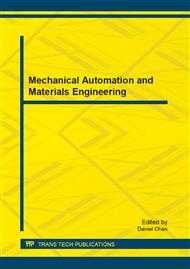p.817
p.822
p.828
p.833
p.838
p.843
p.849
p.854
p.859
Recovery Techniques for Complex Grain Boundaries
Abstract:
When estimating the grain size, the processing effect for complex grain boundaries is often poor. To solve this problem, the recovery techniques for complex grain boundary are studied. After analysis of steps to estimate the grain size, we know that it is critical to get more accurate boundary before quantitative determination, and the discontinuous points among grain boundaries should be connected. Therefore, two methods to connect the discontinuous points were established, and it showed that watershed method is more efficient; however over-segmentation and under-segmentation exist. Accordingly, recovery techniques of complex grain boundary were put forward, that is to edit the regional minimum manually or to connect the discontinuous points in the gray image before watershed transform. By this technique, the grain boundary can be got more accurately, conveniently and continuously closed, independently of interfere of noise, scratches, illumination etc.
Info:
Periodical:
Pages:
854-858
Citation:
Online since:
August 2013
Authors:
Keywords:
Price:
Сopyright:
© 2013 Trans Tech Publications Ltd. All Rights Reserved
Share:
Citation:


